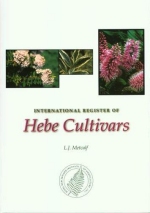BOOK REVIEWS
L. J. Metcalf, 232 pages, ISBN 0-9597756-4-1. Reviewed by Tony Hayter
(aj.me.hayter@boltblue.com) Lawrie Metcalf is the International Registrar for Hebe. In the introduction he describes the frustrations of trying to obtain information for hebe cultivars that have been raised outside New Zealand, where information was either limited, or in some cases lost altogether. There is a brief account of the current state of research on the limits of the genus. This is followed by a brief history of the introduction of hebes outside New Zealand, and the naming of the genus. Also mentioned is that the Hebe genus can be divided into 10 informal groups (although hybrids between hebes in differing groups can cause problems in assigning them to a group). In the first section Phil Garnock-Jones describes the origins and evolution of Hebe. Hebe with Parahebe, Chionohebe and Heliohebe* forms the Hebe complex, which occupies many regions and habitats in New Zealand. By studying a range of characteristics of the complex, including the DNA sequences, Garnock-Jones and fellow researchers are able to infer their evolutionary history. (*The paniculate group of hebes, e.g., Hebe hulkeana.) Hebe and allies probably evolved from the northern hemisphere Veronica complex. The nearest relative is the Australian genus Derwentia, which includes digger's speedwell. A significant evolutionary advance was the closed terminal bud of Hebe, which protected the growing tip from frost and allowed a shrubby habit. Hebe and its relatives seem to have arrived in New Zealand about 10-15 million years ago, the parent having crossed the Tasman Sea. The Heliohebe hulkeana group split early from Hebe. Chionohebe and Parahebe are closely related and there may be some reclassification necessary. Research is continuing, and a fully illustrated field guide to Hebe is to be published in 2002. The second section, by Peter Heenan, relates the history of Hebe as a garden plant. The first explorers of New Zealand sent plants to the leading botanic gardens of Europe. After 1840 the explorations of resident botanists (eg Colenso and Kirk) fostered the founding of domestic botanic gardens and a horticulture trade. Many hebes were sent as seed to Britain in the 19th century. In particular Isaac Anderson-Henry of Edinburgh did much to popularise Hebe. By the end of the century there were about 40 species in cultivation. At the beginning of the 20th century Dorrien-Smith sent Wardian cases of New Zealand plants to Britain, including new introductions such as Hebe buchananii and Hebe bollonsii. This process has continued with botanists including Graham Hutchins collecting and introducing hebes. The first named hebe hybrid was Hebe 'Rosea', raised in 1845 from open pollinated seed of Hebe speciosa; indeed this species was a parent in many 19th century hybrids. Anderson-Henry used it in the first artificial hybrid, crossing with Hebe stricta to give Hebe 'Andersonii'. Hebe breeding programs have continued on and off in Britain and New Zealand, with Jack Hobbs of Auckland raising the Wiri series in the 1980s. The history of hebe cultivars has been plagued by poorly described, poorly documented plants, with no herbarium specimens. Indeed even botanic gardens had difficulty with their species; it turned out that plants of Hebe cupressoides were the hybrid Hebe 'Azurea'. Since 1840 there has been a steady increase in the number of hebe cultivars introduced and named. The variety of habit, leaf size, leaf shape, flowering time and habitat requirements of hebes enables them to be grown in a variety of garden situations. Training Hebe speciosa as a standard was accomplished as early as 1847. Their use as pot plants was noted in 1887, and in 1990 over 2.5 million hebes were grown as pot plants in Denmark. Much attention has been paid to the frost tenderness of hebes, the early literature discussing it in 1880, with research continuing to the present. In the third section of the register Lawrie lists over 1000 hebe cultivars. What makes this particularly useful is inclusion of synonyms. Thus we are told that Hebe 'Autumn Beauty' of New Zealand nurseries is the same as Britain's Hebe 'Autumn Glory', and that Hebe 'Knightshayes' is a synonym for Hebe 'Caledonia'. The fourth section is a similar listing for Heliohebe. Following this are 16 good colour plants of hebes. The fifth and largest section is the 'Biographical List of Hebe Cultivars'. This contains descriptions, and the source for the descriptions, of nearly 700 hebes. For example Lawrie gives us five references for Hebe 'Andersonii', and follows with a brief description, and historical notes. The length of the entries vary, the largest occupying a page, smaller ones just one line; and depends on the amount of information available to him. The sixth section lists the biographical data for the heliohebes. This well produced book will appeal to all members having an interest in the origins of their hebes. The books by Douglas Chalk and Graham Hutchins are largely horticultural, with a leavening of botany, so the International Register of Hebe Cultivars will complement them well. Available from: The Royal New Zealand Institute of Horticulture |
Home | Journal
| Newsletter | Conferences
Awards | Join
RNZIH | RNZIH Directory | Links
© 2000–2026 Royal New Zealand Institute of Horticulture
Last updated: March 1, 2021


